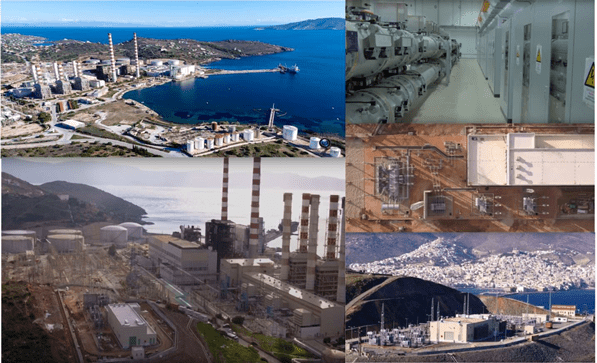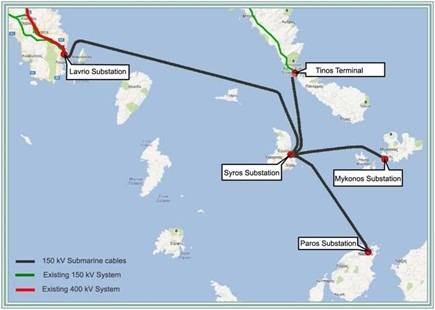The ongoing climate change demands radical changes to critical infrastructures aiming to save energy and reduce carbon emissions. Towards this goal, the interconnection of remote areas with the national grid is a top priority for the EU and the member states.
The non-interconnected areas (e.g. islands that are not connected to the national electrical grid) are normally electrified by local power stations (Autonomous Power Stations – APS), which, however, are costly and result in a high carbon footprint, since they burn imported fossil fuels. The interconnection of these areas with the national grid will allow them to be electrified by the existing power infrastructure, whereas regions with high renewable energy potential will be able to infuse clean energy to the national grid, improving the overall national energy mix and contributing to the national economy.
However, the advanced automation equipment that is used to control the new segments of the interconnected grid (smart inverters, Programmable Control Units – PLCs, Remote Terminal Units – RTUs), increase the attack surface, and the fluctuations observed in the renewable energy sources introduce significant challenges in terms of ensuring the security and stability. Considering that the grid interconnection can also establish the preconditions for wide-area cascading effects, new solutions are required to ensure stability of electrical grid and mitigate possibly disastrous cascading effects with severe impact to other critical infrastructures (e.g. healthcare) or high-value economic activities (e.g. tourism).
The 3rd pilot of SDN-microSENSE, “Large-scale Islanding Scenario Using Real-life Infrastructure”, which will take place in Greece, concerns the validation of the SDN-microSENSE platform in the new interconnection of the Cyclades islands with the mainland. This interconnection is one of the most important interconnection projects both at national and European level. The project started in 2007 with a budget of € 389,059,862.79, co-funded by EU and managed by the Independent Power Transmission Operator (IPTO) and is expected to be completed in 2024. Upon completion, the new interconnection will bring significant advantages for Greece, such as:
- Reduced energy costs that will be reflected to energy consumer’s bills.
- Reduction of the environmental burden for the islands since APS will no longer operate.
- Reducing the country’s dependence on fuel imports.
- New opportunities for the development of new large-scale projects to maximise the renewables potential of the islands, resulting to a cleaner energy mix and new jobs.
- Strengthening the local and national economy.

Therefore, this pilot will provide the unique opportunity for the SDN-microSENSE consortium to validate the efficiency of the platform in the context of a high-impact innovative project that paves the way for similar interconnection projects in Greece and EU. In more detail, the pilot concerns 4 different scenarios of intentional islanding, and energy supply and demand management, involving the following locations:
- IPTO substation in Lavrio.
- IPTO substation in Syros island.
- IPTO substation in Mykonos island.
- IPTO substation in Paros island.
- The 385MV combined-cycle power plant of Public Power Corporation (PPC) in Lavrio.
The SDN-microSENSE platform will be deployed in the IPTO substation in Lavrio, the interconnection point of Cyclades and the mainland, where real-time electricity measurements will be collected and analyzed by leveraging the novel SDN-enabled RTUs provided by Schneider Electric, enhanced with new cybersecurity functionalities. By analysing the operational data, SDN-microSENSE will detect indications of power outages and disruptions caused by cyberattacks, natural disasters or operational malfunctions, and will suggest islanding schemes to prevent the spreading of cascading effects or a general blackout. At the same time, the platform will be able to propose load shedding actions to ensure load and supply balance on each island to stabilize the frequency and improve power quality.

References:
[1] European Commission, “Connecting Greece’s Cyclades Islands to the mainland’s power grid”. [Online] Available: https://ec.europa.eu/regional_policy/en/projects/greece/connecting-greeces-cyclades-islands-to-the-mainlands-power-grid
[2] IPTO, “Cyclades Interconnection Phase A Paros-Syros-Mykonos” [Online] Available: https://www.admie.gr/en/erga/erga-diasyndeseis/diasyndesi-kykladon-fasi-paros-syros-mykonos
[3] IPTO, “Cyclades Interconnection Phase B Andros – Tinos – Naxos” [Online] Available: https://www.admie.gr/en/erga/erga-diasyndeseis/diasyndesi-kykladon-b-fasi-andros-tinos-naxos
[4] Pictures are taken from: https://www.nikost.gr, https://www.youtube.com/watch?v=ZfDCyOiHux8 and https://www.pm-partners.gr/cycladic-islands-interconnection-with-the-hellenic-power-transmission-system/

Pingback:Towards Securing Large-Scale Grid Interconnection Infrastructures – Metaminds Innovations